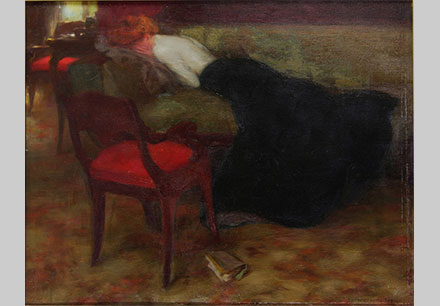
STANISŁAW
BOHUSZ-SIESTRZEŃCEWICZ
(1869–1927)
The realisation of the presentation funded
as part of the programme EU Interreg Lietuva-Polska
Project: LT-PL-5R-389
Impromptu [The Crying Lady]
Impromptu
[The Crying Lady]
1903, signed SIESTRZEŃCEWICZ in the right lower corner, oil, canvas
61 x 76,7 cm
Mazovian Museum, Płock.
This piece of art entered the canon of Polish modernist painting. The artist based the colour composition on the black spot of a skirt which is worn by a lying woman. It has restless, wavy lines and it is matched with the white of the woman’s blouse. The redness of the seats and chairs standing next to the ottoman creates a safe aura around the crying lady. The golden light, seeping through the window located in the top left corner of the composition, envelops the room with a warm glow. Despair is juxtaposed against safety, white against black, dark against light, the simple line of the ottoman’s rest against the wavy shapes of chairs, warm light coming through the window against the shadows enfolding the wall and the blackness of the costume. The artistic effect of showing a scene which does not fully fit into the frame (a fragment of the window, a chair and an ottoman limited by the edges of the painting), gives the composition a particularly intimate and psychologically authentic character. The viewer gets the impression of direct but also discreet observation of the situation.
Impromptu is a musical term, meaning (among other things) an interlude, a pause between the acts of a theatrical performance filled with music. It is a subversive title whose symbolic meaning fully expresses the psychological character of the scene. The heroine of Impromptu finds her life momentarily suspended between some of her activities and this intimate moment is filled solely with her emotions. Between acts of everyday reality, there is an interlude expressed with tears.
The turn of the XIX and XX century saw a revaluation of the female role, which is evident in the painting. There were classical and traditional roles of a mother, a giver of life, a matron and a wife who dazzled with beauty and richness of the costume which was a mark of a status. Next to these models, however, there appeared the persona of the destructive femme fatale who leads men astray. There were also figures of lost women subjected to the influences of demonic seducers as well as representations of free, happy and beautiful women. The representative function of a female portrait was replaced by an expression of her intimate, individual image. Women were depicted in places considered to be their natural environment such as a living room, a garden, around blossoming flowers, in spaces allowing for the natural evocation of personality not subjected to external pressure. Artists also discovered the world of their own sensitivity and emotionality in these portraits. They presented their wives and muses in intimate situations: combing their hair, drinking morning coffee, during their beauty routine. On canvas they recorded girlfriends’ conversations, cafe flirtation and moments of deep sadness.
Impromptu fits into this modernist perception of a woman and Stanisław Bohusz-Siestrzeńcewicz does it in a particularly beautiful and subtle way. He reveals the mystery of female emotions without violating the personal boundaries of the woman he is portraying.
Impromptu, so different from the rest of his work, makes him one of the most interesting and sensitive artists of Polish modernism.




